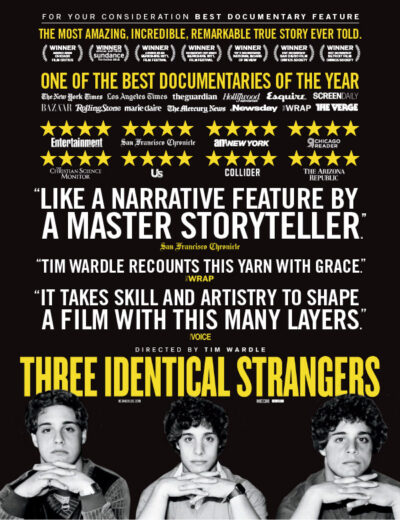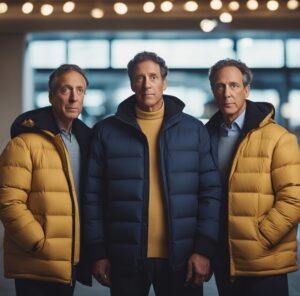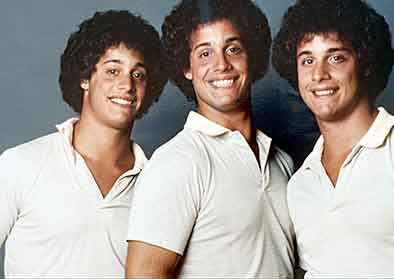Not merely a superior documentary, but an example (perhaps the last example) of a format that has since been upended by Netflix. This is to say that THREE IDENTICAL STRANGERS (2018), advertised as “The Most Amazing, Incredible, Remarkable True Story Ever Told,” is presented as a feature film, in which form it handily maintains one’s attention and lasts no longer than it needs to (whereas today the material would most likely be stretched into a multi-part whole and confined to the small screen).
THREE IDENTICAL STRANGERS 2018 (Trailer)
It tells the story of the New York based Jewish triplets Robert “Bobby” Shafran, Eddy Galland and David Kellman. Their saga began in 1980, when at age nineteen Bobby turned up for his first day at Sullivan County College and learned that Eddy, a stranger who looked exactly like him, had already attended. The two promptly met up and it seemed all was well with them until David, upon reading a newspaper story about Bobby and Eddy’s reunion and noting they closely resembled him, got in touch.
This newly reunited trio originated at Louise Wise, an adoption agency that catered to Jewish families. The agency’s overseers allegedly split the triplets up as infants because they didn’t believe they’d be able to place the three of them together, which initially seemed an acceptable explanation to Bobby, Eddy and David.
They became immediate media darlings, dressing alike, renting a NYC apartment together and enthusiastically partaking of the 1980s New York nightlife. The party lasted until the early 1990s, when the triplets opened a swanky restaurant called, appropriately, triplets. It was then that the guys began getting on each other’s nerves, while a hotshot journalist began looking into the activities of Louise Wise and made some highly unsettling discoveries.
It’s not fair to reveal what happened next, as a large part of this film’s allure is its consistently surprising narrative. This is due largely to how it was constructed, with director Tim Wardle parceling out background information on a strict need-to-know basis: Bobby, Eddy and David initially seem like normal, well adjusted fellows, but this turns out not to be the case, with the uglier aspects of their respective upbringings and the unsavory circumstances of their adoptions filled in during the film’s second half, when the warm and optimistic aura of the opening scenes gives way to a much darker tone.
The film is sympathetic to the struggles faced by its subjects, although Wardle can be creditably accused of manipulation in his twisting of this saga into a novelistic narrative. Eagle-eyed viewers might notice that only two of the three triplets are directly interviewed about their experiences—there’s a definite reason for that, although we’re not informed what it is until the final third. Questionable tactics, perhaps, but the proceedings are always absorbing.
If nothing else, the film is jam-packed. A simple treatment with talking heads would have sufficed, but Wardle incorporates dramatic recreations, vintage photos and extensive 8mm home video footage. He also explores a subplot involving Elyse Schein and Paula Bernstein, twins who like this film’s main subjects were separated as infants and turned out by Louise Wise, and would appear to have life stories that are every bit as shocking and unpredictable as those of the triplets.
Vital Statistics
THREE IDENTICAL STRANGERS
Neon/CNN Films
Director: Tim Wardle
Producer: Becky Read
Screenplay: Grace Hughes-Hallett, Tim Wardle
Cinematography: Tim Cragg
Editing: Michael Harte
Cast: Robert Shafran, Michael Domnitz, Howard Schneider, Ellen Cervone, Alan Luchs, David Kellman, Hedy Page, Alice Shafran, Elliott Galland, Eddy Galland, Richard Kellman, Justine Wise Polier, Mort Shafran, Ilene Shafran, Janet Kellman, Brenda Galland, Lawrence Wright, Natasha Josefowitz, Elyse Schein, Paula Bernstein



